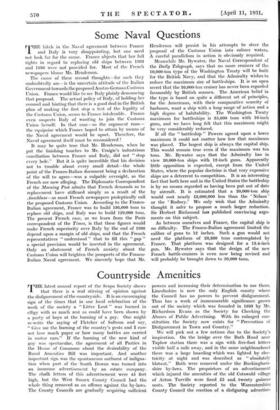Some Naval Questions
THE hitch in the Naval agreement between France and Italy is very disappointing, but one need not look far for the cause. France objects that her full rights in regard to replacing old ships between 1933 and 1936 were not provided for. Most of the French newspapers blame Mr. Henderson.
The cause of these second thoughts—for such they undoubtedly are—is the uncertain attitude of the Italian Government towards the proposed Austro-German Customs Union. France would like to see Italy plainly denouncing that proposal. The actual policy of Italy, of holding her counsel and hinting that there is a good deal in the British plan of making the first step a test of the legality of the Customs Union, seems to France intolerable. France even suspects Italy of wanting to join the Customs Union herself. In that case—so the argument runs— the equipoise which France hoped to attain by means of the Naval agreement would be upset. Therefore, the Naval agreement itself must be reconsidered !
It may be quite true that Mr. Henderson, when he put the finishing touches to Mr. Craigie's industrious conciliation between France and Italy, did not " stop every hole." But it is quite incredible that his decision not to trouble about every small detail—the whole point of the Franco-Italian document being a declaration of the will to agree—was a culpable oversight, as the French are now alleging. The Diplomatic Correspondent of the Morning Post admits that French demands as to replacement have stiffened simply as a result of the Anschluss—as most French newspapers proleptically call the proposed Customs Union. According to the Franco. Italian agreement, France was to build 136,000 tons to replace old ships, and Italy was to build 129,000 tons. The present French case, as we learn from the Paris correspondent of the Times, is that these figures would make French superiority over Italy by the end of 1936 depend upon a margin of old ships, and that the French representatives " understood " that to fill this " gap " a special provision would be inserted in the agreement. Only an abatement of French anxiety about the Customs Union will brighten the prospects of the Franco- Italian Naval agreement. We sincerely hope that Mr. Henderson will persist in his attempts to steer the proposal of the Customs Union into calmer waters. A careful parallelism in action is obviously required.
Meanwhile Mr. Bywater, the Naval Correspondent of the Daily Telegraph, says that no more cruisers of the 10,000-ton type of the Washington Treaty will be built for the British Navy, and that the Admiralty wishes to reduce the maximum size of battleships. It is an open secret that the 10,000-ton cruiser has never been regarded favourably by British seamen. The American belief in the type is based on quite a different set of principles, for the Americans, with their comparative scarcity of harbours, want a ship with a long range of action and a high degree of habitability. The Washington Treaty maximum for battleships is 35,000 tons with 16-inch guns, and we have long felt that this maximum might be very considerably reduced.
If all the " battleship " Powers agreed upon a lower maximum it could not matter how low that maximum was placed. The largest ship is always the capital ship. This would remain true even if the maximum was ten tons. Mr. Bywater says that the Admiralty has in view 20,000-ton ships with 12-inch guns. Apparently little opposition is expected, except from the United States, where the popular doctrine is that very expensive ships are a deterrent to competition. It is an interesting fact that both here and in the United States the battleship is by no means regarded as having been put out of date by aircraft. It is estimated that a 20,000-ton ship would cost nearly £3,000,000 less than the ' Nelson' or the ' Rodney.' We only wish that the Admiralty thought it safer to propose a much larger reduction. Sir Herbert Richmond has published convincing argu- ments on this subject.
As between ourselves and France, the capital ship is no difficulty. The Franco-Italian agreement limited the calibre of guns to 12 inches. Such a gun would not need the platform of 28,830 tons contemplated by France. That platform was designed for a 13.4-inch gun. Mr. Bywater says that the design of the new French battle-cruisers is even now being revised and will probably be brought down to 20,000 tons.










































 Previous page
Previous page